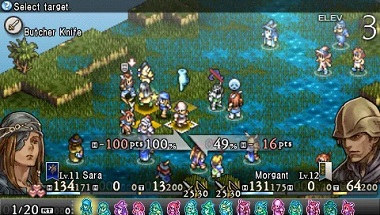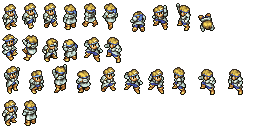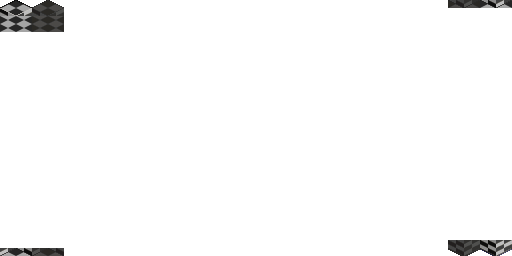Secret Room
Tactics Ogre Secret Room

Ever since I first played Tactics Ogre for the PSX in the late 90s, I’ve wondered how they managed to create such a beautiful game with the constraints of early 1990s technology. The brains behind this wonderful series, Yasumi Matsuno, had an idea for releasing multiple games in the same world known as the Ogre Battle Saga. Work on the game, which was the second release in the Ogre Battle Saga series, began as early as 1992 and was released in 1995 for the Super Famicom console in Japan. In 1996 an updated version was released on the Sega Saturn which featured increased resolution and partial voice acting, among other things. It eventually came to the PlayStation in 1997 (JP) and luckily the west finally got it’s hands on it in 1998.
At the time, in the west, most of us didn’t realize that the PSX version was actually not too great compared to the SNES and Sega Saturn versions. It had issues with slowdown during battles as well as lower quality sound playback.

The best thing to happen was the subsequent PSP remake in 2011 (NA). I say this mainly because it sparked more interest in the series as a whole which created a community around releasing translated versions of the older games (SNES English patch was released in 2010, and the Sega Saturn English patch was released in 2023) as well as creating mods. It’s also a great game and added a ton of bonus content including one of the coolest systems ever brought to tactical role playing games: The Chariot System!
Tactics Ogre (SNES/PSX/SAT) is a very different game than Tactics Ogre: Let Us Cling Together (PSP). Tactics Ogre: Reborn, which was released in 2022, is essentially a port/semi-remake of the PSP version. That being said, each one is a very distinct experience. If one was going into the series fresh and was only planning to play one, I’d probably suggest they play the PSP version. It’s hard not to suggest the SNES/SAT versions, especially now that the latter has an English translation, but the PSP version allows the player to access the full story, which has multiple branching paths, without having to restart the game. One should definitely play the original if they haven’t, it’s a very different experience. The Sega Saturn version is in my opinion the best way to experience the original. The SNES version is also great, just stay away from the PSX version if you can. It’s tough saying that since the PSX version was my introduction to the game.
Background
So this page is more than just a short Wikipedia article. Even before I started developing Dusk Tactics, I was deeply invested in Tactics Ogre. The world, the lore, the potential of a seven or eight game epic high fantasy series spanning multiple consoles that used Queen songs as their sub-titles. Unfortunately, that last one was a lot of work in an industry that is increasingly harder to make your mark in, let alone continue creating new things.
There are different interpretations of the numbering in the main Ogre Battle Saga series, but it generally looks like this:
- ???
- ???
- ???
- ???
- Ogre Battle: The March of the Black Queen
Real Time Strategy (1993 SFC, 1995 SNES) - Ogre Battle 64: Person of Lordly Caliber
Real Time Strategy (1999, 2000 N64) - Tactics Ogre: Let Us Cling Together
Turn Based Strategy (1995 SFC, 1998 PSX, 2011 PSP) - ???
The Side Story games take place before the games listed above, some like to put them as #3 and #4 on the main list.
- Ogre Battle Gaiden: Prince of Zenobia
Real Time Strategy (2000 NGPC) - Tactics Ogre: The Knight of Lodis
Turn Based Strategy (2001, 2002 GBA)
I would love to see a continuation of the main Ogre Battle Saga, which would most likely feature the original Ogre Battle as one of the earlier games, literally a battle between Heaven and Hell. There has been talk, mostly through interviews with Matsuno, of an Episode VIII, which the natural conclusion would be the second Ogre Battle possibly involving many characters from the previous games.
Research
The main reason I decided to create this page is that a lot of my research, done over the past decade or so was made up of bookmarks to websites that unfortunately no longer exist and have not been archived. Prior to the mod Tactics Ogre: One Vision, much of the information about the inner working of the game could be found on a zetaboard website, which I can’t find. Tactics Ogre: One Vision by raics is one of the most detailed mods that exists for the game and is definitely worth a playthrough. There’s a lot of information I was able to piece together thanks to this project.
Sprites
One of the necessary, but still very cool things about the sprites are that they are extremely small, in both size and number of frames, but they somehow allow for an incredible range of motion during battle. Of course cutscenes have their own unique sprites, but the base battle sprites are composed of 28 frames in all (it varies a bit). Since this is isometric, we need four (4) directions, but we can simply mirror front and back so ultimately we only need two (2) versions, so that’s 14 for the front and 14 for the back facing directions.

- Standing
- Walking A/B
- Damage A/B
- Crouch/Stretch
- Action A/B/C/D/E
- Dead
This minimalist design had a huge impact on how I proceeded. For example, the walking animation, which is also the idle animation, goes something like this:
Standing -> Walking A -> Standing -> Walking B
The Crouch/Stretch are used in conjunction with the 5 “Action” frames to form every combination of weapon attack, unarmed attack, item usage, or special ability. Sometimes other frames are used, but you get a lot out of very few frames.
The Dead frames are somewhat new to the PSP version as dead units would simply disappear in the older version. Undead units would probably be the only units that had ‘Dead’ frames for when they’d been stilled.
The PSP version features use of shaders and most likely normal mapping to simulate lighting and the discolored altered states. The modern versions of the games aren’t held to the hardware restrictions faced by SNES developers, so I’d be interested in knowing how the modern version handles palettes, it might have been easier to simply store the textures rather than rely on live palette swapping.
Note: A lot of this info is off the top of my head, I’ll do a proper edit at a later date, I just wanted to get this info down.
Tileset/Map
The far more interesting aspect of Tactics Ogre is how they went about laying out their tilesets to create those beautiful battlefield maps. It is extremely hard to find any information regarding exact specifications or specific sizes of tiles, and how they differ for each version, so most of this is pure conjecture.
There’s a lot of interesting resources within the UMD, these include assets from the SNES version of the game that aren’t used in the PSP version. Specifically the world map icons, which have a new unique look in the PSP remake.
I’m not going to focus on a specific console and ultimately most of this is just me guessing, so keep that in mind. The PSP version seems to use the same textures as the SNES version for the most part. On the PSP the map may be assembled in 3D (billboard), which allows for that overhead view. The overhead view uses what looks to be upscaled 32×32 tiles. It also restricts the tile variation, you may notice that switching to overhead mode makes the map less detailed as it substitutes similar terrain with the closest upscaled tile.
For the SNES version the maps are flat drawings, usually having a single layer for the majority of tiles and a second layer that has edges and overlap bits so those can be drawn over the units.
If you look closely at the map in-game, you’ll notice that every so often there’s a minor section that doesn’t line up 100%. In the grand scheme of things, this is very hard to notice, but it’s due to how the map is tiled. As I mentioned above, it’s not drawn in a traditional isometric fashion (I mean it is, but we’re not going to get too technical, it’s orthographic). It’s been a long time since I messed around with the SNES, but the way they store tilemaps is based on the current Mode the game is using. Here I think we’re working with 16×8 tiles (Mode 5/6?). Anyway the maps are made up of these smaller sub-sections that comprise every possible tile needed, this includes transition tiles, edges, bottoms, tops, etc.

The image above is an interesting one. It looks like a template for tiles and, for the PSP, at least, each map has it’s own ’tileset’ that comes in 512×256 chunks. The image is broken down into columns, each of which contains a specific tile/terrain base.
The top left starts with the edge tile and as it goes down, it’ll contain transitions between the chosen terrain and another terrain. It’s almost like a multiplication table, it’s definitely a table of some sort, with an index based lookup system.
The bottom right contains the “wall” part of the tile. It makes up a very small part of the tileset even in maps with lots of tiles as the walls are typically made of repeating patterns. Again, I don’t know the actual size of the tiles and it may use different sizes, but I am assuming it’s 8 pixels high. 32×8? Those top left tiles look like 32×16, but there may be times when you just want the top 8 pixels, so maybe the standard is 8 pixels.
Going any deeper is outside the scope of my research as I am not making a SNES game, although it would be neat to fight with minimal resources and POT restrictions.
Heightmaps
Here’s something I found rather recently. It’s interesting in a reverse engineering sort of way, but someone was able to use Wolfram Alpha to create heightmaps from the images of the complete maps. It uses machine learning along with you providing some info and it’s essentially able to plot a graph of walkable tiles which includes their heights and relative locations. It was even able to create a block-map from this data.
I’m afraid of losing this resource, so I may copy it to this website because, I mentioned earlier, links don’t last forever.
